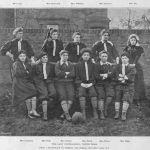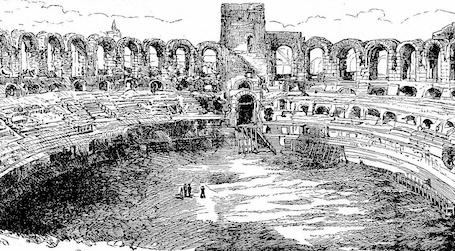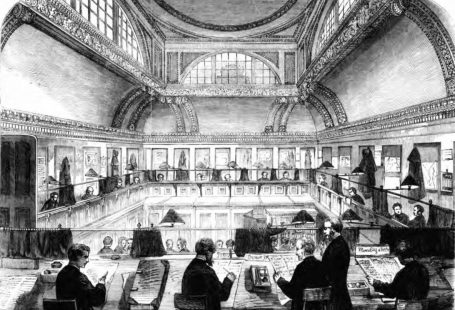150 years ago this March, on 16 March 1872, the first ever FA Cup final was played between the Wanderers and the Royal Engineers.
Register now and explore the Archive
In this special blog, we will take a look at this historic match, which was played at Kennington Oval in South London, using newspapers taken from the time, as well as a very special account that was written some 66 years later.
The Association Challenge Cup Final Tie
On 13 March 1872 the Maidenhead Advertiser published this short announcement:
The final tie will take place on Saturday afternoon next at the Oval, commencing at 3 o’clock punctually, between the Wanderers and the Royal Engineers. Admission one shilling.

This historic footballing occasion, the first Football Association Cup Final, was detailed in just two sentences.
But how did the two teams get to the final? The Sportsman, one of our specialist sporting titles, outlines the Wanderers’ and the Royal Engineers’ path to the final, on 19 March 1872:
It may here be as well to state that during the earlier heats the Royal Engineers had defeated the Hitchin Club, the Hampstead Heathens, and the Crystal Palace, all without difficulty; while on the other hand the Wanderers had only defeated the Clapham Rovers by one goal, having drawn with the Crystal Palace, and enjoyed a walk over in their tie with the Harrow Chequers.
And so it was, going into the final, the Royal Engineers team were the favourites for the title:
Mainly in consequence of their easy triumph over the Crystal Palace Club on the previous Saturday, the Engineers were great favourites with the public, and that the estimation in which they were held was not unjustifiable may be gathered from the fact that for a period of two years they had never been vanquished.

Also attending the March final that day was 22 year-old Henry Mathews, who wrote a piece for the Daily Mirror in April 1938 entitled ‘I Saw The First Cup Final.’ Recalling the events of some 66 years before, Mathews described how:
You see, as a lad of twenty-two, assisting my father in a hosiery business just off Kennington-road, I saw the FIRST Final – the Final of 1872…I remember it as though it were yesterday – that sixteenth of March sixty-six years ago. I managed to persuade father to let me have the afternoon off – and along I went with a friend, who had never seen a football match before but who was keenly interested in this new game that was destined to fire the country.
Top tip: you can find accounts of events in our newspapers from after the time they happened, so it’s sometimes worth not restricting your search by date.
‘Fashionable’ Spectators
The first FA Cup Final had sparked interest from the public, and not least from Henry Mathews and his friend. The Morning Post on 18 March 1872 describes how ‘there was a vast number of spectators’ in attendance at the match, ‘including many ladies in the tent, and there were several open landaus on the ground.’
Indeed, as Mathews points out in his Daily Mirror piece, the crowd that had gathered to watch the football that day was ‘fashionable’ one, for ‘football was a ‘society’ game then.’

Meanwhile, The Sportsman reported how:
…the assemblage of spectators [was] very fashionable, though the numbers were hardly so large as might have been expected, owing, possibly, in some measure to an advance in the price charged for admission.
The advertisement in the Maidenhead Advertiser gave the price of admission as 1 shilling (just over £3 today), whilst Henry Mathews recalls paying 2 shillings (or £6 today), not an insignificant amount then.

And Mathews paints an incredibly evocative picture of the crowd as they gathered to watch the match:
…strings of cabs and private carriages were drawn up outside the gates of the old Oval, giving the whole occasion a garden party atmosphere. Street urchins running alongside the moving buses and cabs reaped a rich harvest of coppers thrown by the well-to-do young bloods out to find a new thrill in this novel game of football.
He estimated that there were ‘fully 400 people there waiting for the match to begin:’ compare that to the over 85,000 people that attended the 2019 FA Cup Final between Manchester City and Watford at Wembley Stadium.
And so, the crowd was ready, and all that was needed was for the match to begin.
‘Remarkable Animation’
But there was some delay in starting the match, Henry Mathews for the Daily Mirror fondly recalling how ‘football matches rarely began at the scheduled time.’ He and his friend were standing alongside the pitch on duckboards, having not been able to ‘secure one of the favoured positions behind the goals.’
Meanwhile:
There were the usual pre-match arguments about the size and shape of the ball – it was all very primitive then – and there were further delays while the two teams, the referee and the umpires were photographed!

Mathews then helpfully explained to his modern football audience what duties the two umpires had to perform:
The umpires? You will ask. Yes, we had goal judges in 1872. Nets weren’t invented, so an umpire stood by each goal to decide whether the ball had gone through the posts, round the side or over the top! Even when he had decided, fierce arguments often broke out among rival players, though there was no occasion for goal-disputes in this game.
Disputes settled, The Sportsman reports how ‘within a few minutes of three o’clock the ball was set in motion by the Engineers,’ the captain of the Wanderers having won the toss. And it was the Wanderers who:
…went to work with the greatest determination, and at the outset their play forward displayed more co-operation than is their custom, the backing-up being vastly superior to anything they have shown during the present season.
Before the game the Wanderers were very much the underdogs, but it was the Wanderers who were to take first blood, and score the only goal of the game:
By this means, and with the aid of faultless kicking of the part of their backs, they were able during the first quarter of an hour to besiege the Sappers closely, to the surprise of many of the spectators. Thus consistently they maintained the attack, till at length, after some judicious ‘middling’ by R.W.S. Vidal, the goal of the Engineers fell to a well-directed kick by A.H. Chequer.

There was no let up for the Royal Engineers in the second half of the game, The Sportsman detailing how:
Ends were now changed, but any expectations of an alteration in the state of affairs were unfulfilled, as without any diminution of energy the Wanderers, although now faced by wind and sun, continued to besiege the lines of the Engineers without allowing any opportunities to the forwards on the latter side of effecting the rushes for which they are noted.
However, the newspaper reports how the ‘game was maintained with the most remarkable animation on both sides,’ with Muirhead for the Royal Engineers making ‘an excellent run…into the vicinity of the Wanderers’ fortress,’ but this was dealt with by A.C. Thompson, and ‘the leather was safely removed.’
‘A Perfectly One-Sided Match’
As the second half progressed, ‘one or two chances were offered to the Wanderers, but none were realised.’ The Sportsman put this down to the ‘extremely efficient goal-keeping of Captain Merriman.’
Meanwhile, Henry Mathews for the Daily Mirror outlined some of the differences in watching football, between 1872 and 1938:
It was even more difficult to follow play than it is to-day, for though the game was slower, the spectator was hampered by the fact that both teams wore the same type of rigout – caps, shirts, long flannel trousers – and belts! It was the practice to tuck the bottom of the trousers into the stockings, as lads do nowadays when they play in their impromptu dinner-hour games.
But perhaps worst of all were the ‘shooting boots,’ which possessed ‘inch-long spikes,’ causing Mathews to exclaim ‘Woe betide the player who mistimed his tackle!’

And the very art of football, the art of the beautiful game, was different back in the 1870s, as Mathews explains:
Passing was an unknown art in those days. The idea was for a player to get the ball at his toes and keep it there by dribbling until he lost possession. Charging – real honest-to-goodness Corinthian charging – was permitted; in fact, was so much part of the game that any attempt to rule it out would have meant no game!
But despite these limitations and differences, it was the Wanderers who emerged victorious that March day, The Sportsman reporting how:
During the latter part of the game it was generally imagined that the Engineers would outstay their opponents, but until the finish the play continued as fast as ever, and soon after half-past four o’clock time was called, the Wanderers thus gaining the privilege of holding the cup for a year by one goal.

Indeed, The Sportsman writes how the ‘Wanderers unquestionably surprised the spectators by the effectiveness of their play,’ the Engineers having ‘played hard and well throughout.’ However, the Engineers only ‘endangered the enemy’s goal’ on two occasions, and the Morning Post was a lot less charitable about their performance:
The Engineers worked hard, but could not alter the state of affairs. It was a perfectly one-sided match, the Wanderers taking it comparatively easy, only defending their goal, having obtained their object by coming into possession of the trophy. The Engineers could never get within many yards of their opponents’ quarters. It would be needless to state any other particulars.
The Sportsman put the Wanderers’ ‘superiority’ down to their back players, with the ‘certainty of the kicking displayed by Lubbock and Thompson throughout [enabling] the forwards of the victors to attack without fear.’
However the Royal Engineers did suffer from some bad luck; ‘one of their best players,’ Lieutenant Creswell, ‘broke his collar-bone about ten minutes from the start.’ Henry Mathews remembered this incident, and recalled how the injured player carried on ‘playing to the finish.’ Indeed, The Sportsman commended Creswell for ‘the pluck he showed in maintaining his post, although completely disabled and in severe pain.’

And ‘thus ended one of the most pleasant contests in which the Wanderers have ever been engaged,’ Mathews for the Daily Mirror remembering the ‘great enthusiasm’ that the teams were met with at the game’s end:
Cheers were given to both winners and losers; the players trooped off the field to bathe their bruises and we spectators made off home.
The Sportsman, meanwhile, reported how the cup itself would be presented at the ‘annual dinner of the Wanderers’ Club, to be held early next month,’ and gave a full list of the players who had participated on both sides that day:
Wanderers: C.W. Alcock, E.E. Bowen, A.G. Bonsor, A.H. Chequer, W.P. Crake, T.C. Hooman, E. Lubbock (back), A.C. Thompson (half-back), R.C. Welch (goal), R.W.S. Vidal and C.H. Wollaston.

Royal Engineers: Capt. Marindin, Capt. Merriman, Addison, Mitchell, Creswell, Renny-Tailyour, Rich, Goodwyn, Muirhead, Cotter and Bogle.
And although the football played on 16 March 1872 was very different to the football played today, it is remarkable that such a tradition has endured for 150 years, surviving global conflicts and changes in fashion, to still be one of the most important and celebrated football trophies in the world.
Explore more sporting history on The Archive by browsing our special sporting titles, and look out for more football history posts on our social media channels.






